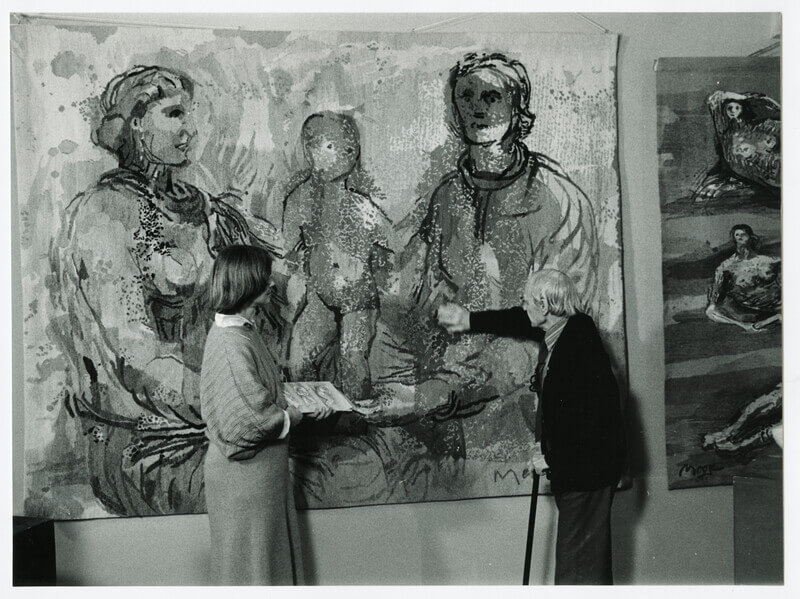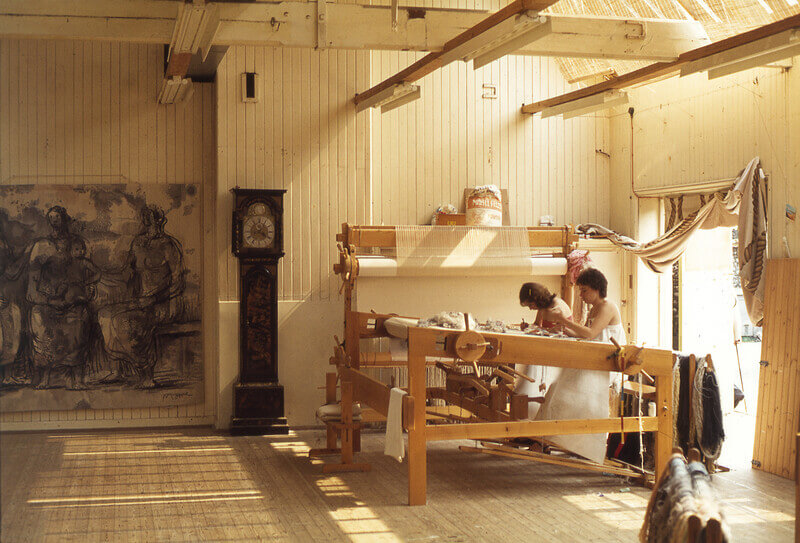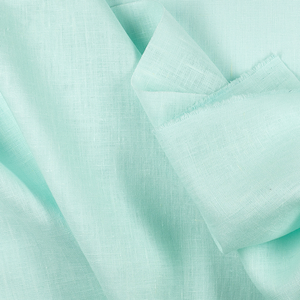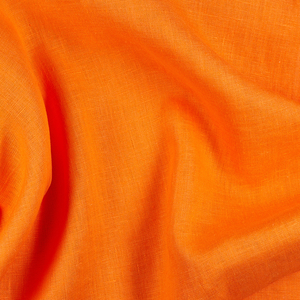Weaving Drawings: Henry Moore’s Tapestries
Henry Moore is best-known today as an esteemed sculptor who made a significant contribution to post-war British art. Through his world-renowned sculptures and drawings, he opened up a daring new language of abstraction, one influenced by the nuanced shapes and forms of the human body, and the way one person relates to another. But perhaps less well-known is Moore’s relationship to tapestry and weaving; throughout the 1970s and beyond, he worked closely with a series of master weavers to produce a series of richly tactile wall hangings that translated his established visual language into tightly woven designs, each one unique from the last. He said, “the beauty of tapestry is that it is different, an interpretation, and that to me is the excitement and the pleasure.”

Detail from Henry Moore’s tapestry Three Women in a Landscape, 1979, demonstrating the skillful portrayal of the artist’s marks with woven thread
Henry Moore first became interested in weaving during the late 1940s. In collaboration with the renowned weavers Dovecot Studios in Edinburgh, Scotland (who have produced weavings based on artworks by many of the world’s most significant artists) Moore made his first tapestry, which was translated from one of his watercolour drawings on paper. Enlarging imagery from a small, densely worked drawing took time, care and patience from the skilled weavers, who worked multicoloured layers deep into the weave of the fabric. On the one hand, they replicate Moore’s expressive visual language, yet they also reveal something new, an unexpected complexity within the artist’s work. Building on the success of this enterprise, Moore went on to work with the Scottish Weavers of Brose Patrick Studio from 1971 to 1974.
In 1976, Moore’s daughter, Mary Moore, introduced her father to the West Dean Tapestry Studio near Chichester in England, which was one of the few dedicated weaving studios in the UK at the time. Subsequently, Moore went on to collaborate closely with them on a series of 23 large-scale tapestries from 1976 to 1986, all copied from the artist’s own watercolour drawings. The artworks Moore selected for the series were made throughout his career, and relate to three of Moore’s enduring themes – the mother and child, the reclining human figure, and the interaction between large and small forms.
Recreating Moore’s original drawings as large-scale tapestries was no small task – it took a highly skilled team of weavers, led by master weaver Eva-Louise Svensson, many months of preparation and work. One of the most important aspects of the process was the careful and considered dyeing of wool to colour match Moore’s art, as well as blending individual threads into a series of tonal variations, in order to capture the incredibly subtle surfaces Moore created while blending watercolour and pencil onto paper. What they managed to avoid through all this careful preparatory work was the pixellated, gridded effect that so many tapestries often have when seen up close – instead, their tapestries are closer to large-scale, hand-painted images.
Together they created a series of monumental wall-hangings that are around eight times than the original drawings, offering us a chance to experience the sensuous materiality of Moore’s work on paper up large. This series from West Dean is now widely recognised as Moore’s most celebrated tapestry work, and the weavings from this group have been the subject of many major international exhibitions in the past few decades, including displays in the UK, New Zealand, the United States, Canada and Hong Kong. On the one hand, the final results reveal just how tonally dense, and visually complex so many of Moore’s drawings were, and the time, care and dedication he devoted to his work on paper. But they also show how closely interrelated the acts of drawing and textiles can be, and how, through acts of creative collaboration, one can be translated into the other, with surprising and refreshing results.

















































3 Comments
Cassandra Tondro
Thank you for introducing us to Henry Moore’s tapestries. I wasn’t aware of them until now, and they’re beautiful!
Elisabeth Crago
I had the privilege of seeing some of the Moore tapestries created by the West Dean weavers on a trip to the Victoria and Albert Museum in London in 1980. We happened upon them, having no idea of their existence. I have never forgotten it and thank you for this trip down memory lane. Stunning–the tapestries and the drawings.
Vicki Lang
A wonderful form of art. The pictures created are so original about every day life. The tapestries are beautiful.